|
|
26.10.06
We spent a significant portion of the
day photographing rocks hafted to sticks. It seems that if you tie a rock to
a stick, it is no longer just tied, it is 'hafted'. In the interest of
taking the most descriptive photos possible, we had an extended and
completely serious discussion on which side of a rock you would use to bash
in someone else's skull.
I voted for the pointy end.

Oh, and those four websites in development: now it's six.
Underemployment to overemployment in about a month, not bad for
turnaround.

And here's an interesting article on atheism:
http://wired.com/wired/archive/14.11/atheism.html
I was going to capitalize 'atheism', but it seemed
antithetical.
24.10.06
Ah yes, full-time work with a nice long commute; that was the reason I never posted very often before. Because I am utterly insane I’m also developing four websites for people and doing a rush on a promotional design. I choose sleep over eloquence.
22.10.06
The hunters return triumphant! We have tracked the fabled puffballs to their lair and poked them mightily. More photos to come.
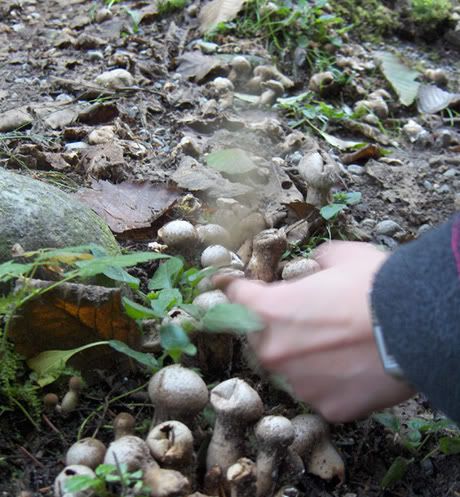
21.10.06
One of my favourites, the Toothed Jelly Fungus, Pseudohydnum gelatinosum, is clear with little teeth to increase surface area on the spore-bearing underside.
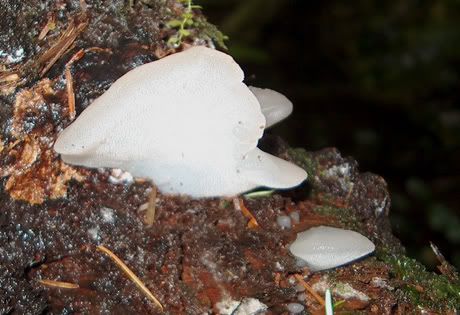
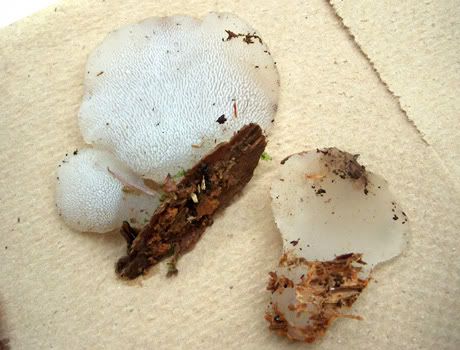
19.10.06
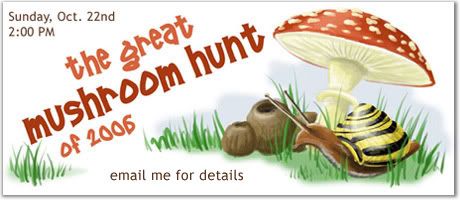
18.10.06
The crows are ripping up the lawn to get at the chafer beetles. There are flickers doing this too, but since I like seeing them, I don’t resent them as much. Partly it’s our fault, as the lawn is composed of a significant amount of shallowly rooted (that’s an inaccuracy, but “rhizoided” isn’t a word) moss. We have a neighbour who, every year, applies moss killer to his lawn then rakes it all up producing fourteen bags of moss to be taken away by the irate recycling people. I like moss, it grows slower than grass and it’s soft and doesn’t turn brown in drought. I also like a diverse lawn, monocultures are boring. Unfortunately the crows like moss too because it’s easier to pull up than grass. And once one starts and is successful in finding food, the ripped up patch becomes a homing beacon to various murders of crows flying by. The patch then grows.
I usually try and shoo them from the lawn by moving the curtains in the window or opening the door. I think it’s the same two crows doing most of the damage, as whenever I do this, one flies right to the edge of the lawn and the other perches on a fire hydrant across the street. They then sit there are wait until I go away. I suggested we buy a scarecrow and pass it off as Halloween decoration, but I know better than to try and outsmart a corvid. We were out there this weekend, I raked the bits back onto the bare patches and stomped them down. The crows sat on the fire hydrant and watched. The ill will flowed both ways. I’ve seen these two crows drive off other crows from “their” lawn and there were a few flicker feathers lying on the grass as well. We have guard crows.
The city sent around a flyer advocating biological control through the application of nematodes at a certain stage in the beetle’s life cycle, so we’ll have to wait until next summer to give it a go. In the meantime, I think the crows are winning this battle.

Waiting rooms are dang odd places. A young guy walks in, dressed with such self-conscious trendiness as to be wearing seersucker pants and white sneakers. He walks up to the receptionist and gives his name as “Lucky”, explaining that he’s late for his appointment. The receptionist searches for a bit and says, “You’ve had nine appointments and missed them all, I called and told you to go elsewhere”.
He says “I had one and I couldn’t make it”.
“I’m seeing three right here.”
“Maybe two or three….”
“Well never mind, you’re here now,” said the receptionist without rancour, which I thought was gracious.
At this point his cell phone goes off, with one of those loud obnoxious ringtones stolen from whatever happens to be popular on the Beat right now (or something like that). He answered it. The girl next to me let out a rather choked laugh, I resolutely looked at the paper I was reading and tried not to guffaw. “I’ll call you back,” he said, and finished his check-in procedure. He sat down and we all tried desperately not to look at each other.
16.10.06
I’m working with people, I have co-workers with whom I am constantly
interacting: this is new and strange. Painting houses could be considered my
first “real job”, the typical summer job for young naïve students, but the
crew were all my friends from before, so they were never just co-workers. The
retail involved other people, entirely too many actually, but I was seldom
with other people from the company. The usual situation would be me working
alone in a different venue every few weeks working alongside new faces and
meeting random people. The lab had people, great people with whom I still
hang out, but everyone was doing their own thing and had their own distant
offices and would disappear for weeks at a time to do field work. And the
biology building was vast and labyrinthine enough that I could enter one of
the many doors, wind my way to the often-empty lab, work the whole day, and
leave without seeing anyone I knew. And I’ve already told you about the
hermitage that is freelancing.
Not so anymore. I realize this is a far more common situation to be in, and
that it’s my own freakishness that had led to all my previous jobs being so
insular. On arrival at the museum, I sign in at security and say hi to those
on duty, go to the lunchroom to drop off food (banned from the collections
areas, with good reason) where there are likely to be more people, walk down
an exceptionally long hallway in which you run into other people arriving,
pass through a lab and by a workshop, and go through packing and survey areas
before arriving at the studio where two people have desks and I work with a
team of four other people to move and photograph objects. The number of times
I say “Hello” and “Good Morning” exhausts me before I get to my computer. And
because the museum is so isolated from the rest of campus, there isn’t
anywhere to go during breaks and lunch other than the staff room, particularly
if the weather’s bad.
The closest I’ve experienced to this is four months of working constantly
with Pavel*, another NSERC grant recipient at the start of my time in the
lab. We got along well and voluntarily had lunch together, but we were also
the same age, same educational background, and were both pretty laid-back (or
I’d like to think so anyway). This group is far more diverse, though most
people have some kind of fine arts or museum studies background. The age
range is large, I suspect I’m the youngest, judging from my supervisor’s
reaction to finding out my year of birth, and I’m going to refrain from
guessing exactly how old my co-workers are, as they are predominantly female
and I’m bad at that kind of thing anyway. I don’t really know anyone well
enough yet to start speculating on possible personality conflicts, but so far
so good. And hey, we are on public display (the studio is also known as “The
Fishbowl”), so if things go bad it could just turn into a live version of
reality TV.
 *Not his real name, nickname give to him by anonymous contributors who
perceived a physical resemblance to a famous Pavel, though this one is of
Dutch ancestry and to my knowledge has no connection with rockets.
*Not his real name, nickname give to him by anonymous contributors who
perceived a physical resemblance to a famous Pavel, though this one is of
Dutch ancestry and to my knowledge has no connection with rockets.
15.10.06
Work update: things are going well, there is much more to learn, but we’re trying out new procedures and have begun to take photos. This week was an introduction to the place, people, and equipment. I’ve already told you about the equipment, but that was before I used it. This stuff is a photographer’s dream; one of our cameras is worth more than my year’s salary. The lighting coddles our objects in perfectly diffuse and even light. We can pick our optimum camera settings and adjust our brilliant lights to give us the perfect exposure. Our computers instantly display our photos, take care of custom white balance, and do our image processing automatically. It almost seems too easy…
Except when things go wrong. There are so many connections in the chain from light to useable file that a problem in any one link can bring the system down. I don’t look forward to the day something goes wrong with the lights. Fiddling with computer software I can do, but with a box packed with enough electricity to kill you? Not so much. The lenses have been great so far, but each is only good for a certain range of object sizes, changing a lens involves re-adjusting the camera mount, light levels, and white balance before being able to resume shooting. The cameras themselves have their own particular quirks, whether it’s going to sleep for no reason or refusing to release the shutter. On two cameras, the sensor is a separate part. The sensor is connected to the computer and sometimes they don’t like each other. The computers themselves have been good, except for some confusion when we were installed as new users. Errors in the image capture program have mostly been due to human error. Usually, with a bit of patience and consultation, we can work out the problems and get on with the day.
Electronics being electronics, however, sometimes stuff screws up for no reason. One of our cameras refused to auto focus for us one afternoon. It was
towards the end of the day and we were losing the ability to think anyway, so
the timing wasn’t great. It’s a nice camera and we knew what it could do, it
just wasn’t doing it. We switched to manual mode and we all had a go at
taking some photos. None of us could produce a clean image focussed on the
bit we were trying to get. Granted, my photography experience at this level
is limited, but the other photographers have degrees in this, something was
wrong. I suggested the viewfinder diopter was off, which it was, but that
still didn’t fix the problem. We still didn’t have a solution by the end of
the day. Security was coming around to turn off the lights (we’re on the same
set of lights as the public gallery) and we had to ask them to wait so we
could pack up our stuff before walking out through a dark museum. The next
day we set up the same camera to the same computer and everything was working
perfectly.
So after all the drama of the week and the troubleshooting and working with practice objects, we finally started on the museum collection on Friday afternoon. Real objects, cultural artifacts of great significance, towering achievements of the human experience, right? We got rocks. Sure, it said it was a Maori fishing weight, but it looked a heckuva lot like a rock.
 Okay, it did rain quite a bit today, I guess it's good that we didn't go... but just wait till next week.
Okay, it did rain quite a bit today, I guess it's good that we didn't go... but just wait till next week.
14.10.06
'shrooms postponed.
Due to weather, the majority of respondents has opted to move the date to next sunday, all other details the same.
10.10.06
Wow, information overload; building layout, object handling protocol, object tracker software, MIMSY software, new photo equipment, Capture One software, and scores of new names and faces. I’m too exhausted and excited to write coherently, so you get vignettes.
The group of new hires could easily be distinguished as the group of people with agressive eyewear and multiple piercings wearing nothing but black.
Our not-latex gloves are vivid purple, barney-coloured grape kool-aid purple.
My primary workstation is about two metres away from museum visitors, and well within earshot of the display of large wooden bells that visitors are encouraged to “tap gently”. I’m sure I’ll get used to it, but that’ll be a fun process.
“Your camera will be hooked up to your G5.”
*goes lightheaded*
Based on prior experience (ie. mites), I have been appointed Lord of Small Things. The workstations are designed around the size of objects they are capable of photographing. My jurisdiction is “small to tiny”. No jokes from you, thank you very much.
Everything seems really good so far, tomorrow I may actually get to touch a camera.
09.10.06
Alright, last day before I start the new job. I’m looking forward to it, but allow me one moment of nostalgia. Now that I’m not staring down the barrel of being a permanent freelancer (I shudder to think about filling in that particular income tax return), I can put on my rose-coloured glasses and take a misty look back at what life was like.
*Insert cheesy flashback music.* On any given day I could wake up late, find some food, check my email, make tea, then get in a few hours of work before lunch. I’d wander to the kitchen whenever I got hungry, nuke whatever was in the fridge, eat watching TV or reading, then get back work. When the parents came home, all productivity was lost with the interruptions and noise and preparation of dinner. I’d sit down again around 8pm and work a bit more, getting in about as much work time in total as your standard office day. Frequent breaks prevented burnout and no one cared if I was in my sweatpants building their website.
I also did that thing where you lose track of days, sincerely believing that no, today’s Thursday, not Friday. And I wanted it to be Thursday because then I would have another day before the weekend. I preferred weekdays to weekends because I could get the house to myself and be more productive, and not feel guilty about taking breaks.
A commute time measured in seconds instead of hours was also incomprehensibly wonderful.
And now all that’s ending. Back to morning alarms and the daily slog through the city on crowded buses. On the other hand, I’ll no longer be a hermit, growing increasingly pale and weird in my isolation. Also I’ll get to set aside the financial insecurity of never knowing when the next project will come up. It will also make it easier to explain to my grandparents that yes, I am actually working; you try explaining freelance web design to them. As for the highs and lows of the new job itself? Well you’ll just have to stay tuned to find out.
08.10.06
Happy Thanksgiving I suppose. I forgot to post these earlier:
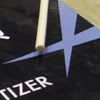



 In other news, I've updated the illustration page of the portfolio.
In other news, I've updated the illustration page of the portfolio.
07.10.06
I went to the Art Gallery today, as they were charging one one-hundredth of what I usually pay for admission. Granted, they do have by-donation nights on Tuesdays, but that’s not always the most convenient time for people. Usually the place is fairly quiet, but not today. A crowd of people was blocking the entrance to the Carr show, I looked at the second half first, then doubled back to check out the first bit. There were kids, whole families, old people; it was a remarkable scene, even if we were all in each other’s way. The gallery was alive with chatter and parents telling their kids not to touch anything. Rooms of brightly coloured visually stimulating objects, but keep your hands behind your back. It is a sore temptation for more than just kids, prominent DO NOT TOUCH signs were beside some paintings: one with a mirror-finish varnish over a black background, one made of wax, assemblages of wood and cloth and paint.
The Carr show should not be shocking to anyone familiar with the VAG’s collection, although it was nice to see pieces from other collections on display. The second floor is dedicated to Paint, showing examples of painting since the ‘60s. One of the large two-storey end galleries has been converted into a stunning salon of large-scale contemporary paintings. Shadbolt, Onley, Yuxweluptun, Lukacs, Smith, stacked three high on all four walls. Also impressive were the small-scale photorealistic watercolours of Tim Gardner. The third floor was dedicated to works from the gallery collection that present differing views on depicting First Nations culture, which means you get more Carr paintings. The fourth floor is usually home to Emily Carr, but since she’s moved downstairs, an exhibition of portraiture of Canadians (“Portrait of a Citizen”) has moved in, as well as a display of single-person dwellings built from salvaged material by the homeless in Japan, oddly appropriate in the newly vacated space.
I think there’s more stuff to look at than usual, since Carr got her own show and new stuff is on the fourth floor; I was on visual overload by the time I was done. Go if you’re so inclined, but the VAG also has decent virtual exhibitions of “First Nations: Myths and Realities” and “Portrait of a Citizen” (among others) on their website (http://projects.vanartgallery.bc.ca/publications/75years/).
If you feel like you’re missing out on something when you look at art, remember these things: your opinion is as valid as anyone else’s; sometimes there is no meaning; and just because it’s in a gallery doesn’t mean it’s any good. Now go forth and artify.
05.10.06
On skytrain I pass through the concrete and plywood chaos that is the high-
density housing construction boom. I was saddened to see a large swath of
greenspace, really just forested undeveloped land around a few lonely houses,
being destroyed for a new development. One of my friends referred to it as
a “clearcut”, and while I disagreed on the basis that commercial logging
clearcuts are far worse in terms of scale and environmental damage, it did
paint an apt picture. For the people who pass the area everyday, the impact
of losing those trees probably exceeded that of losing unseen acres of old-
growth forest out there somewhere in the wilderness.
There are still a few big trees left on the lot, and marketing has jumped on
this, using them as a selling point in their print ads. They are extolling
the virtues of nature after having destroyed it to achieve their commercial
goals. In doing this, whether they are aware of it or not, they have chosen
very appropriate names for the buildings.
I first noticed them on the background of the big signs; low-key italicized
script spelling out Thompson, Fitzgerald, Harris, MacDonald, Lismer, Jackson, Carmichael, Varley. I thought they
were trying to go for subtle cultural capital. Then the glossy brochures
arrived and the names were applied to the various buildings on the site. The
cover of the brochure has a pseudo-impressionist image of autumn trees, which
looks suspiciously like a Photoshop filter. The names belong to the members
of the Group of Seven and their associates, those icons of Canadian art who
defined a visual identity for this country in the middle of the 20th century.
That lone pine tree in the blazing colours, those almost-abstract snowscapes
that look like they’re made of rolled fondant; that’s them. They are mythic, some were
war artists, and they embody the image of the painter alone in nature,
capturing the raw beauty of the empty Canadian landscape. That’s probably
what those crafty marketers were going for.
There is, however, another side to the story. To some, the Group of Seven
was a boy’s club of well-to-do white men with close connections to resource
industries. Despite knowing Emily Carr quite well, she was never considered
one of them, and at least one member of the Group was a seemingly unabashed racist. This sexism and racism has been read in the images they produced.
Also, an art history professor had us look at the dates locations of their wilderness paintings and they
parallel the expansion of the railway into Northern Ontario. It seems our
boys were stepping off the train and painting whatever was in front of them,
leaving out the unappealing realities of the human impact on the environment.
And so we are repeating our national pastime of resource exploitation for commercial gain; the legacy lives on. The names of most condominium developments range from innocuous to inane, but this one burrowed into my brain. It seems Canadian culture has been co-opted into a brand name, even if most Canadians wouldn’t recognize it. However, the histories are still there, just under the skin, and like the landscape, you cannot simply blot out the bits you don’t like. Names have power, and the land holds many secrets, before you mess with either, you’d better know what you’re doing.
 Dang, biology and art history in one rant, I love those intersections.
Dang, biology and art history in one rant, I love those intersections.
04.10.06
This is a Shaggy Mane, Coprinus comatus. The cap dissolves into black goo from the edges inward to release the mature spores.
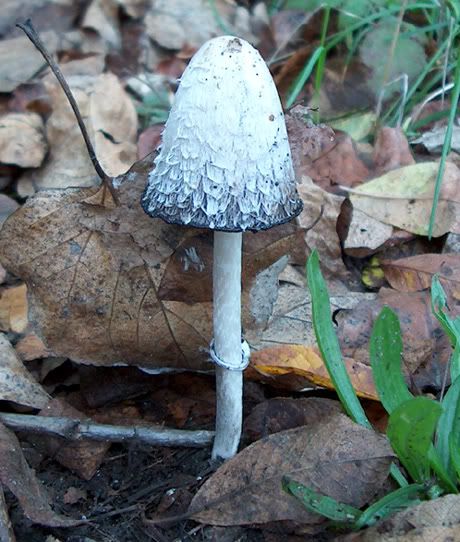
Photo was taken two years ago on some turf by the church on the south side of University Boulevard by UBC.
02.10.06
The unmistakeable fairly tale toadstool, the Fly Agaric: Amanita muscaria. Poisonous and hallucinogenic, with highly variable effects depending on locality, this mushroom has some great stories connected to it involving the Lapp people, reindeer, and climbing into houses through the chimney. And hey, the colours are ...red and white. Hmmm.
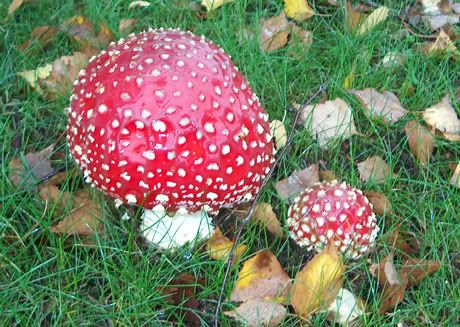
The photo was taken on the corner of 8th Ave. and Blenheim two years ago, the larger mushroom is the size of a canteloupe, biggest one I've ever seen.
01.10.06
The nights are cool, the trees have turned russet and ochre and all those colours that make you think of apple cider and fireplaces, and the Christmas merchandise is in stores now: must be fall. And you know what this means: the mushrooms are out.

These are Yellow Pholiotas, Pholiota flammans, found today on the side of a log on Burnaby Mountain. The scaly caps and stipes are usually characteristic of the genus. The bright yellow colour and slimy surface of the cap help to distinguish it from other Pholiotas.
|
|
©d.tan  |













